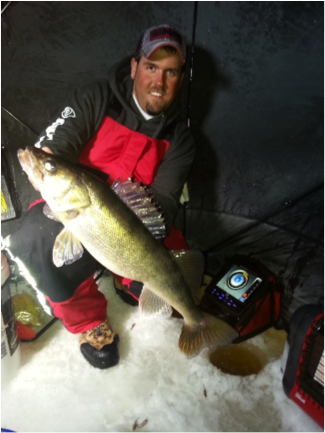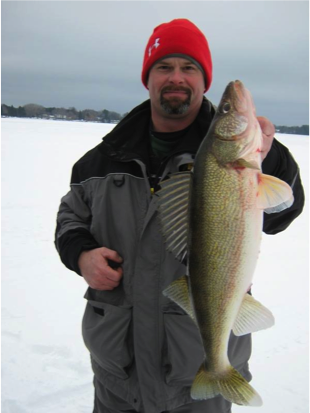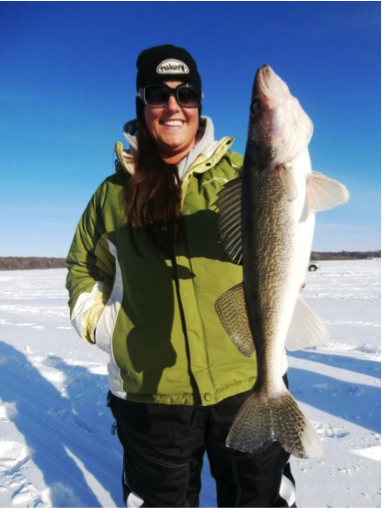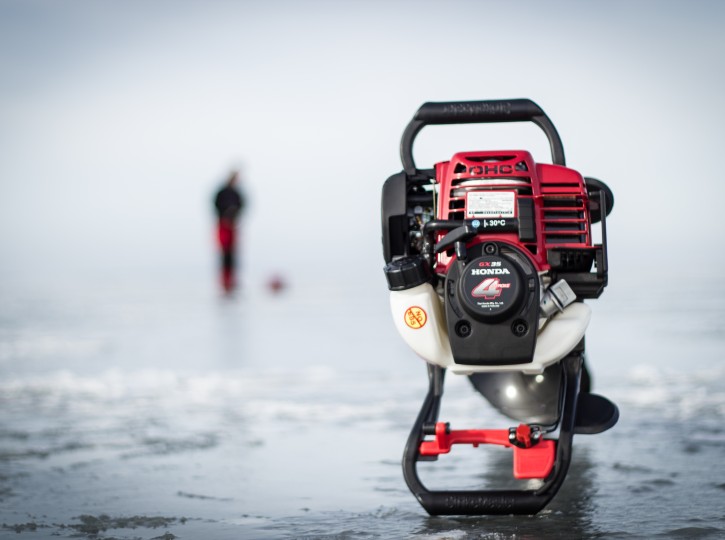I believe that the “first ice” period is one the best times to target Walleyes upon many of our lakes and reservoirs. There are a few factors that make this the best time period of the ice fishing season. One being that in most places over the past couple of months these fish haven’t seen a whole lot of fishing pressure due to the fact that many outdoorsman are out in the woods chasing whitetails and other game during the fall; this gives these fish a little bit of a break. Another factor that affects early ice is that the Walleyes are still continuing with their fall feeding binge.
 Let’s first start with safety! You really need to be careful at this time of year, as well as the rest of the ice fishing season. Just because there is safe ice at the access point doesn’t mean that there is safe ice everywhere! Wind, temperature, and currents can change the thickness of ice by the hour. As a general rule of thumb, 2 inches of solid clear ice is enough to walk on, 4-6 for an ATV or snow machine, and 12+ for a vehicle. When walking out on that first sheet of ice take a spud and periodically check the thickness of the ice. A set of safety picks are also a great item to have; if you happen to fall through, picks will allow you to grip the ice and pull yourself out of the water and to safety.
Let’s first start with safety! You really need to be careful at this time of year, as well as the rest of the ice fishing season. Just because there is safe ice at the access point doesn’t mean that there is safe ice everywhere! Wind, temperature, and currents can change the thickness of ice by the hour. As a general rule of thumb, 2 inches of solid clear ice is enough to walk on, 4-6 for an ATV or snow machine, and 12+ for a vehicle. When walking out on that first sheet of ice take a spud and periodically check the thickness of the ice. A set of safety picks are also a great item to have; if you happen to fall through, picks will allow you to grip the ice and pull yourself out of the water and to safety.
There is no set time period for this bite. However, once people are able to drive vehicles on the ice, this bite will slow, because it is a shallow water deal. I am going to relate most of this to Reservoir fishing, due to the shallower, stained water base. This approach can also be successful in your favorite lakes. The most important part of catching Walleyes through the ice at this time of year is location. Once you find them they are relatively easy to catch.
I start my search by looking for secondary river/creek channels. These channels are a highway for Walleyes as they move around throughout the season. The most important item you are looking for at this time of year are shallow flats (1-5 feet deep), that meet the channel (10-20 feet deep). A lot of these reservoirs are littered with wood and rock. If you can find these areas with a sand and wood, or sand and rock transition this will greatly increase the number and size of eye’s that you will catch.
 At night Walleyes will school up and roam these shallow flats looking for an easy meal. I like to arrive at these feeding areas an hour or two before the sun hits the horizon. This allows me to drill numerous holes and set up before the fish arrive. When you’re fishing in this shallow water you want to keep your noise to a minimum after dark, or you risk the chance of driving them out of the area. The best way to target these fish at night is with a tip-up. If you are in a state that lets you run multiple lines it is a great way to cover water and increase your odds. I will scatter these tip ups as shallow as one foot of water, to five feet of water at the deepest across these flats. On my tip ups I use 50# Suffix Tip Up line with 6 feet of 17# fluorocarbon for a leader. The heavy fluorocarbon will keep your line from being cut on the bottom of the hole when fighting a big fish. At the end of this leader I clip on a small split shot and use a #8 or #10 VMC Round Bend treble hook. Attach a 4-6 inch sucker or shiner, set your rig 12-18 inches off of the bottom and you are in business.
At night Walleyes will school up and roam these shallow flats looking for an easy meal. I like to arrive at these feeding areas an hour or two before the sun hits the horizon. This allows me to drill numerous holes and set up before the fish arrive. When you’re fishing in this shallow water you want to keep your noise to a minimum after dark, or you risk the chance of driving them out of the area. The best way to target these fish at night is with a tip-up. If you are in a state that lets you run multiple lines it is a great way to cover water and increase your odds. I will scatter these tip ups as shallow as one foot of water, to five feet of water at the deepest across these flats. On my tip ups I use 50# Suffix Tip Up line with 6 feet of 17# fluorocarbon for a leader. The heavy fluorocarbon will keep your line from being cut on the bottom of the hole when fighting a big fish. At the end of this leader I clip on a small split shot and use a #8 or #10 VMC Round Bend treble hook. Attach a 4-6 inch sucker or shiner, set your rig 12-18 inches off of the bottom and you are in business.
If night fishing is not your deal there are still some great daytime opportunities for these fish. As the sun comes up the Walleyes will start to move off of the shallow flats they head towards the channel breaks, where they will hang out for the remainder of the day. Now the key is targeting the high percentage spots. Instead of drilling out the whole channel, I like to concentrate on points and cups in the channel. With today’s technology and up to date mapping, it is relatively easy to see the sweet spots in these secondary channels. Just as we looked for when fishing the shallow flats, anywhere you can find wood or rock transitions you will greatly increase your odds, as the fish will use the cover to ambush their prey. Most days, walleyes will relate to steeper vertical breaks on the channel edge. For example, if you have a point breaking off of the flat that extends into the channel and drops from 5 feet straight down to 15 feet and then again down to the deepest part of the channel (example 20 feet). Walleyes will sit on the 15 foot lip and push bait into the steep side of the break.
 My favorite way to target these day time eyes are jigging. After you drill out the area you are going to concentrate on it is time to grab your Marcum locator and go to work, most times waiting no longer than a minute before moving on to the next. Once I mark fish I will start with a variety of baits, with different actions, sizes and colors. First and most important is the action. A few of my favorites are the Rapala jigging rap, a VMC Rattle Spoon, and a VMC Tingler Spoon. Each imparts a different action and sound through the water column. With the use of your flasher you can quickly determine the mood of the fish. If they stay on your bait throughout the water column you have the right action. Then it is just a matter of fine tuning the size and color to get them to eat. As far as the rod, reel and line combo you want to use for this, it can be a personal preference. I like to use a fairly long rod to impart more action in the bait I am using, such as 13 fishing’s 29.5” Medium Whiteout Combo. I then team this up with 8lb Invisiline Ice Flourocarbon line. This setup can handle just about everything you intend to use while jigging up Walleyes.
My favorite way to target these day time eyes are jigging. After you drill out the area you are going to concentrate on it is time to grab your Marcum locator and go to work, most times waiting no longer than a minute before moving on to the next. Once I mark fish I will start with a variety of baits, with different actions, sizes and colors. First and most important is the action. A few of my favorites are the Rapala jigging rap, a VMC Rattle Spoon, and a VMC Tingler Spoon. Each imparts a different action and sound through the water column. With the use of your flasher you can quickly determine the mood of the fish. If they stay on your bait throughout the water column you have the right action. Then it is just a matter of fine tuning the size and color to get them to eat. As far as the rod, reel and line combo you want to use for this, it can be a personal preference. I like to use a fairly long rod to impart more action in the bait I am using, such as 13 fishing’s 29.5” Medium Whiteout Combo. I then team this up with 8lb Invisiline Ice Flourocarbon line. This setup can handle just about everything you intend to use while jigging up Walleyes.
Be safe this season, and hit the ice early to enjoy some of the season’s best Walleye fishing!
-Adam Rasmussen

Great article! Can’t wait to get out there
Great information Adam – thanks for the advice! A quick question for you regarding your jigging poles – do you tie your 8lb floro directly to your lures? Or run it to a snap? And you prefer flouro over the ice braids? Thanks for the insight! I’m a noob when it comes to hard water eyes. Haha.
Nathan, I run flouro as my main line as well as the leader. Basically I am putting a swivel in the system to reduce line twist. The down fall with braid is that it freezes, which can make it hard to work with. Flouro also sinks allowing your bait to fall to the strike zone even faster. I always us a snap to my bait for ease of switching up. This allows you to hole hop with one rod, a box of your favorite baits, without wasting time re-tying when you want to make a switch. Hope this helps!
I spend a lot of time on a lake that has murky water. It has a ton of baitfish such as crappie and bluegill (most are around 6″). No perch. There are also no other pike in the lake. The only other predator fish is bass. The lake has a very low population of walleye but also big because of what they eat. They don’t compete because there could literally be hundreds of panfish in a 15 foot radius. The main bottom of the lake is sand. There is some cabbage in the 15 foot deep areas. What setup and area for December ice eyes would be most productive for these elusive eyes?